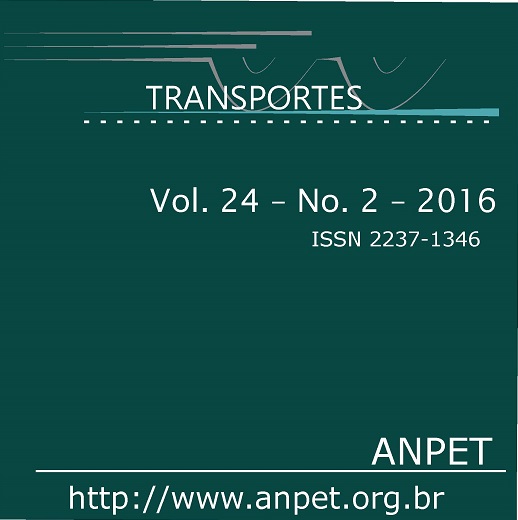Estudo do comportamento da aderência e do conforto ao rolamento em pistas de pouso e decolagem
DOI:
https://doi.org/10.14295/transportes.v24i2.1059Keywords:
Aderência, Conforto, Rolamento, Pistas de Pouso e Decolagem, Segurança.Abstract
Este artigo analisa as relações existentes entre a aderência e o conforto ao rolamento em pistas de pouso e decolagem. Por intermédio dos dados de macrotextura, de coeficiente de atrito e do índice de irregularidade internacional, obtidos entre 2013 e 2014 no Aeroporto Internacional de Fortaleza, foi possível comparar esses parâmetros e suas alterações ao longo da pista. As análises foram efetuadas com base na literatura técnico-científica e nas exigências normativas da Organização da Aviação Civil Internacional e da Agência Nacional de Aviação Civil. Verifica-se que em alguns trechos da pista em estudo, sobretudo no segmento central, o comportamento entre os parâmetros analisados apresenta tendência divergente. Com esta análise, espera-se contribuir para o incremento da segurança das operações de pousos e decolagens, especialmente na resistência à derrapagem, no controle direcional e no conforto ao rolamento das aeronaves.
Downloads
References
ANAC (2012a) Resolução No. 236, de 05 de junho de 2012. Agência Nacional de Aviação Civil. Secretaria de Aviação Civil.
ANAC (2012b) Regulamento Brasileiro de Aviação Civil RBAC no. 153, de 30 de dezembro de 2012. Agência Nacional de Aviação Civil. Secretaria de Aviação Civil.
ALMEIDA, L. C. (2015) Avaliação da irregularidade longitudinal das pistas de pouso e decolagem de aeroportos brasileiros. TCC (Graduação) – Curso de Engenharia Civil. Universidade de Fortaleza, Fortaleza.
BOEING (2014) Statistical Summary of Commercial Jet Airplane Accidents Worldwide Operations 1959 – 2013. Disponível em http://www.boeing.com/news/techissues/pdf/statsum.pdf, Acesso em 18 maio 2015.
CENIPA (2015) Panorama Estatístico da Aviação Civil Brasileira. FCA 58-1. Ministério da Defesa. Comando da Aeronáutica. Centro de Investigação e Prevenção de Acidentes Aeronáuticos. Brasília, DF.
FAA (1997) Measurement, construction and maintenance of skid-resistant airport pavement surfaces. Advisory Circular – AC 150/5320-12C. Federal Aviation Administration. United States Department of Transportation. Washington, DC.
FAA (2009) Airport Pavement Design and Evaluation. Advisory Circular - AC 150/5320-6E. Federal Aviation Administration. United States Department of Transportation. Washington/DC.
FAA (2014) Guidelines and Procedures for Maintenance of Airport Pavements. Advisory Circular – AC 150/5380-6C. Federal Aviation Administration. United States Department of Transportation. Washington, DC.
FONSECA, O. A. (1990) Manutenção de Pavimentos de Aeroportos. Diretoria de Engenharia da Aeronáutica. Divisão de Estudos e Projetos de Infra-Estrutura. Ministério da Aeronáutica. Brasília, DF
GILLESPIE, T. D., SAYERS, M. W.; SEGEL, L. (1980) Calibration and Correlation of Reponse-Type Road Roughness Measuring Systems. National Cooperative Highway Research Program Report, Washington, n. 228, 88p.
ICAO (2002) Manual de servicios de aeropuertos. Parte 2. Estado de la superficie de los pavimentos. Cuarta edición. Organización de Aviación Civil Internacional. Lima, Peru.
ICAO (2004) Annex 14 to the Convention on International Civil Aviation. Aerodrome Design and Operations. Volume I.. 4th Edition. International Civil Aviation Organization. Montreal, Canada.
ICAO (2012) Runway Surface Condition Assessment, Measurement and Reporting. Cir 329. AN/191. Internacional Civil Aviation Organization. Montreal, Canada.
KAZDA, A.;CAVES, R. E. (2007). Airport Design and Operation (2nd Edition). Publisher Elsevier Science. New York, NY
DOI: 10.1108/9780080546438
OLIVEIRA, F.H.L; NOBRE JÚNIOR, E.F. (2009) Acúmulo e remoção de borracha em pavimentos asfálticos do Aeroporto Internacional de Fortaleza. XXIII Congresso de Pesquisa e Ensino em Transportes – ANPET. Vitória/ES.
PIARC (1987). Permanent International Association of Road Congresses Report of the committee on surface characteristics.18th World Road Congress,Brussels, Belgium
SAYERS, M. W.; KARAMIHAS, S. M. (1998) The Little Book of Profiling. Basic Information about Measuring an Interpreting Road Profiles. The Regent of the University of Michigan. 98p.
SUN, L., KAN, S.; JI, Y. (2004) Evaluation and Rehabilitation Models of Airport Pavement Management System: a case study of Shanghai Pudong International Airport. In: 6th International Conference on Managing Pavements. TRB Committee AFD10 on Pavement Management Systems. Brisbane, Queensland, Australia
THOM, N. (2010) Principles of Pavement Engineering. Thomas Telford Publishing Ltd. London. DOI: 10.1680/ppe.58538
TRANSPORT CANADA (2004) Aerodrome Safety Circular. ASC 2004-024. Appendix A – Guidelines Respecting the Measurement, Evaluation and Maintenance of Airfield Pavement Surface Friction. Government of Canada.
Downloads
Published
How to Cite
Issue
Section
License
Authors who submit papers for publication by TRANSPORTES agree to the following terms:
- The authors retain the copyright and grant Transportes the right of first publication of the manuscript, without any financial charge, and waive any other remuneration for its publication by ANPET.
- Upon publication by Transportes, the manuscript is automatically licensed under the Creative Commons License CC BY 4.0 license. This license permits the work to be shared with proper attribution to the authors and its original publication in this journal.
- Authors are authorized to enter into additional separate contracts for the non-exclusive distribution of the version of the manuscript published in this journal (e.g., publishing in an institutional repository or as a book chapter), with recognition of the initial publication in this journal, provided that such a contract does not imply an endorsement of the content of the manuscript or the new medium by ANPET.
- Authors are permitted and encouraged to publish and distribute their work online (e.g., in institutional repositories or on their personal websites) after the editorial process is complete. As Transportes provides open access to all published issues, authors are encouraged to use links to the DOI of their article in these cases.
- Authors guarantee that they have obtained the necessary authorization from their employers for the transfer of rights under this agreement, if these employers hold any copyright over the manuscript. Additionally, authors assume all responsibility for any copyright infringements by these employers, releasing ANPET and Transportes from any responsibility in this regard.
- Authors assume full responsibility for the content of the manuscript, including the necessary and appropriate authorizations for the disclosure of collected data and obtained results, releasing ANPET and Transportes from any responsibility in this regard.











